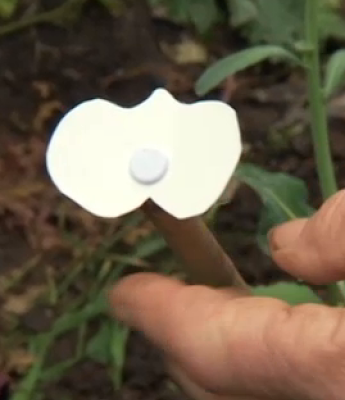The most significant pest affecting Cabbage, Cauliflower, Broccoli and other members of the Brassica family in Spring and Summer is caterpillars that munch away the leaves and that, if unchecked, can make plants completely unproductive. Margaret W is an entomologist and Marg M is a food-gardener with decades of food-gardening experience. This blog post documents their advice on the subject, with further info added by me.
Most people think that it is only the Cabbage White Butterfly (Pieris rapae) that lays eggs on the leaves of Brassica plants. However, Margaret W points out that the lesser-known Cabbage Moth (Plutella xylostella) also known as Diamond Back Moth) does the same. The latter are small grey moths with a white diamond pattern on their wings, most noticeable when they are at rest. Fully grown Cabbage Moth caterpillars are 10 to 12 mm long and bright green in colour. They are voracious and as damaging as the larger dark-green Cabbage White Butterfly caterpillars.
 |
| Cabbage Moth |
Many food-gardeners use Dipel, which the trade name of a product containing bacterium Bacillus thuringiensis or Bt. It is a biological pesticide that is considered environmentally friendly because it very specifically targets caterpillars width little of no effect on humans, wildlife, pollinators and most other beneficial insects. Caterpillars that ingest Dipel stop feeding almost immediately, but it takes around 3 or 4 days for them to die. For best results spray Dipel all over and under leaves, so whatever caterpillars munch from there on has Dipel on it.
Margaret W used Dipel some years ago and found that, when caterpillars are fully-grown, Dipel didn't much help. She began to remove the large caterpillars by hand and squash them. Alternatively you could feed them to your chooks. She still uses this method to date.
Marg M is a current user of Dipel and reckons it works fine on all caterpillars, large and small, so maybe the makers of Dipel increased the strength of the product so it now works against all caterpillars regardless of size. Marg adds a couple of drops of dishwashing liquid to the Dipel to make it stick better to plants, but warns that rain or irrigation will wash it off.
Repeat applications of Dipel every 5-7 days. If you miss a spray because of bad weather, or you went away for the weekend, make sure you check plants, hand-pick any larger caterpillars that may have escaped, before continuing with Dipel applications.
There are other sprays for sale, but they kill beneficial insects as well as caterpillars.
Some people recommend the use of home-made sprays consisting of onion, garlic and hot chilli, but they are not as effective as Dipel and again are non-discriminative.
Margaret W also recommends netting plants to prevent egg laying or physically removing the eggs. Removing the eggs is her approach because she only grows small numbers of these plants. Every few days she goes over her Brassicas and gently rubs off the tiny eggs from the backs of the leaves trying not to damage the tender young leaves. She is considering netting but warns that any net will need to be quite fine to keep out both Cabbage White Butterfly and Cabbage Moth.
Marg Murray recently came up with the following remedy against Cabbage White Butterfly. Her baskets work well for smaller plants:
 |
| Marg's baskets for small Brassicas |
On ABC Gardening Australia an experienced market-gardener talked about Cabbage White Butterflies being territorial. She now places metal white butterflies on sticks (see photo below) in her Broccoli and claims this diminishes damage done by them. Other sources report success with fake butterflies. There are now solar-powered fake butterflies for sale that 'flutter' back and forth. I have seen these solar butterflies at work and they look pretty convincing to me, but, I, as you know, am not a butterfly. Try the fake butterfly method together with other deterrents, as this method may not be 100% effective.
 |
| Butterflies on sticks deter other Butterflies? |
For more info on Cabbage White Butterfly and Cabbage Moth see this NSW Agriculture document:
For more info on Dipel visit https://www.yates.com.au/product/garden-pest-control/yates-40g-natures-way-caterpillar-killer-dipel/, and
Thank you Margaret and Marg for providing the info that made this blog post possible.

....and don't forget to edge your whole vegetable garden with flowering shrubs, herbs and old vegetable plants to attract the small, native birds (who love to eat caterpillars) and predator insects.
ReplyDelete